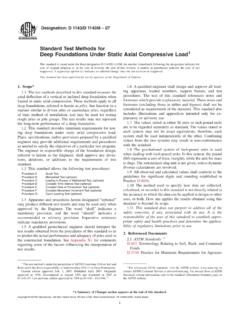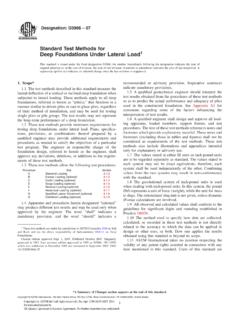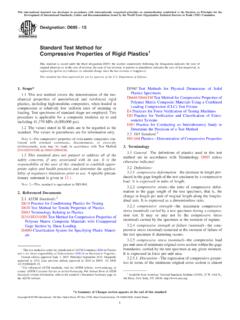Transcription of Standard Test Methods for Deep Foundations Under Static ...
1 Designation: D3689 07. Standard Test Methods for deep Foundations Under Static axial tensile Load1. This Standard is issued Under the fixed designation D3689; the number immediately following the designation indicates the year of original adoption or, in the case of revision, the year of last revision. A number in parentheses indicates the year of last reapproval. A. superscript epsilon ( ) indicates an editorial change since the last revision or reapproval. 1. Scope* A qualified geotechnical engineer should interpret the The test Methods described in this Standard measure the test results obtained from the procedures of this Standard so as axial deflection of a vertical or inclined deep foundation when to predict the actual performance and adequacy of piles used in loaded in Static axial tension.
2 These Methods apply to all deep the constructed foundation. See Appendix X1 for comments Foundations , referred to herein as piles, that function in a regarding some of the factors influencing the interpretation of manner similar to driven piles or cast in place piles, regardless test results. of their method of installation, and may be used for testing A qualified engineer shall design and approve all load- single piles or pile groups. The test results may not represent ing apparatus, loaded members, support frames, and test the long-term performance of a deep foundation. procedures. The text of this Standard references notes and This Standard provides minimum requirements for test- footnotes which provide explanatory material.
3 These notes and ing deep Foundations Under Static axial tensile load. Plans, footnotes (excluding those in tables and figures) shall not be specifications, provisions, or any combination thereof prepared considered requirements of the Standard . This Standard also by a qualified engineer may provide additional requirements includes illustrations and appendices intended only for ex- and procedures as needed to satisfy the objectives of a planatory or advisory use. particular test program. The engineer in responsible charge of The values stated in either SI units or inch-pound units the foundation design, referred to herein as the engineer, shall are to be regarded separately as Standard .
4 The values stated in approve any deviations, deletions, or additions to the require- each system may not be exact equivalents; therefore, each ments of this Standard . system shall be used independently of the other. Combining This Standard allows the following test procedures: values from the two systems may result in non-conformance Procedure Test Section with the Standard . A Quick Test The gravitational system of inch-pound units is used B Maintained Test (optional) when dealing with inch-pound units. In this system, the pound C Loading in Excess of Maintained Test (optional) D Constant Time Interval Test (optional) (lbf) represents a unit of force (weight), while the unit for mass E Constant Rate of Uplift Test (optional) is slugs.
5 The rationalized slug unit is not given, unless dynamic F Cyclic Loading Test (optional) (F=ma) calculations are involved. Apparatus and procedures herein designated optional All observed and calculated values shall conform to the may produce different test results and may be used only when guidelines for significant digits and rounding established in approved by the engineer. The word shall indicates a Practice D6026. mandatory provision, and the word should indicates a The method used to specify how data are collected, recommended or advisory provision. Imperative sentences calculated, or recorded in this Standard is not directly related to indicate mandatory provisions.
6 The accuracy to which the data can be applied in design or other uses, or both. How one applies the results obtained using this Standard is beyond its scope. 1. These test Methods are Under the jurisdiction of ASTM Committee D18 on Soil ASTM International takes no position respecting the and Rock and are the direct responsibility of Subcommittee on deep validity of any patent rights asserted in connection with any Foundations . item mentioned in this Standard . Users of this Standard are Current edition approved Sept. 1, 2007. Published October 2007. Originally approved in 1978. Last previous edition approved in 1995 as D3689 90 (95) which expressly advised that determination of the validity of any such was withdrawn December 2003 and reinstated in September 2007.
7 DOI: patent rights, and the risk of infringement of such rights, are D3689-07. entirely their own responsibility. *A Summary of Changes section appears at the end of this Standard . Copyright ASTM International, 100 Barr Harbor Drive, PO Box C700, West Conshohocken, PA 19428-2959, United States. Copyright by ASTM Int'l (all rights reserved); Mon Jul 5 12:16:21 EDT 2010. 1. Downloaded/printed by Ali Qzaz () pursuant to License Agreement. No further reproductions authorized. D3689 07. This Standard does not purport to address all of the 4. Significance and Use safety concerns, if any, associated with its use. It is the Field tests provide the most reliable relationship be- responsibility of the user of this Standard to establish appro- tween the axial load applied to a deep foundation and the priate safety and health practices and determine the applica- resulting axial movement.
8 Test results may also provide bility of regulatory limitations prior to use. information used to assess the distribution of side shear 2. Referenced Documents resistance along the pile shaft and the long-term load-deflection behavior. A foundation designer may evaluate the test results to ASTM standards :2 determine if, after applying an appropriate factor of safety, the D653 Terminology Relating to Soil, Rock, and Contained pile or pile group has an ultimate Static capacity and a Fluids deflection at service load satisfactory to support a specific D3740 Practice for Minimum Requirements for Agencies foundation. When performed as part of a multiple-pile test Engaged in Testing and/or Inspection of Soil and Rock as program, the designer may also use the results to assess the Used in Engineering Design and Construction viability of different piling types and the variability of the test D5882 Test Method for Low Strain Impact Integrity Testing site.
9 Of deep Foundations If feasible, without exceeding the safe structural load on D6026 Practice for Using Significant Digits in Geotechnical the pile(s) or pile cap, the maximum load applied should reach Data a failure load from which the engineer may determine the D6760 Test Method for Integrity Testing of Concrete deep ultimate axial Static tensile load capacity of the pile(s). tests Foundations by Ultrasonic Crosshole Testing that achieve a failure load may help the designer improve the American National standards : efficiency of the foundation by reducing the piling length, ASME Jacks3 quantity, or size. ASME Pressure Gages and Gauge Attachments3 If deemed impractical to apply axial test loads to an ASME Dial Indicators (For Linear Measure- inclined pile, the engineer may elect to use axial test results ments)3 from a nearby vertical pile to evaluate the axial capacity of the 3.
10 Terminology inclined pile. Definitions For common definitions of terms used in NOTE 1 The quality of the result produced by these test Methods is this Standard see Terminology D653. dependent on the competence of the personnel performing it, and the Definitions of Terms Specific to This Standard : suitability of the equipment and facilities used. Agencies that meet the criteria of Practice D3740 are generally considered capable of competent cast in-place pile, n a deep foundation unit made of and objective testing/sampling/inspection/etc. Users of these test Methods cement grout or concrete and constructed in its final location, are cautioned that compliance with Practice D3740 does not in itself drilled shafts, bored piles, caissons, auger cast piles, assure reliable results.


